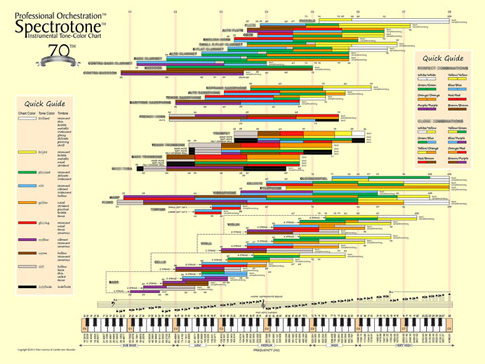If you bought Professional Orchestration Volume 1: Solo Instruments and Instrumentation Notes as a single book (not part of a Home Study Bundle), this Professional Mentor PDF Workbook and Spectrotone Chart will turn it into a complete home study course for you.
The 117-page Workbook guides you from score analysis, to creating a condensed score, all the way through writing and recording 12-13 original works for solo instruments. You also get a Lesson Planner and seven (7) audio lectures explaining how to study on your own.
Using the Spectrotone Instrumental Tone-Color Chart™, you'll learn how to create effective orchestral combinations by register that blend well together or produce a more contrasting tone-color. It's a great reference guide to help you write more quickly.
The Professional Mentor – much more than a workbook
With the Professional Mentor, you'll learn how to study a score and create a condensed score of the excerpt being studied in the Professional Orchestration Vol. 1 book. Creating a condensed score lets you more easily see and understand the structure of the piece you're studying. You’re then encouraged to sequence the excerpt to understand orchestration techniques and compositional insights learned from the example, along with basic MIDI mock-up and recording skills.
Next, you'll write your own original composition using techniques learned from Professional Orchestration Vol. 1 for each of these solo instruments: Flute, Oboe, Clarinet, Bassoon, French horn, Trumpet, Trombone, Tuba, Violin, Viola, Cello, Bass, and Harp. With this approach, you create 13 publishable works (the equal of roughly a semester’s worth of work at college) and you can also write an optional “final” project – a full orchestral arrangement.
Professional Mentor Workbook - Contents
1. Lesson Planner | 2. Score Analysis Guide | 3. Orchestral Sketchpad PDF | 4. Spectrotone Analysis Guide | 5. Spectrotone Range Sheets | 6. Recording Spectrotone Combinations | 7. VSL Self-Study MIDI Mockup | 8. Professional Mentor Writing Assignments | 9. Orchestral Sample Library Evaluation Spreadsheets
Professional Mentor Audio Lectures - Contents
1. Professional Mentor Overview | 2. Score Analysis Overview | 3. Spectrotone Analysis Overview | 4. Spectrotone Range Sheet Assignments | 5. Recording Spectrotone Combinations | 6. VSL Self-Study Overview | 7. Professional Mentor Writing Assignments Overview
Bonus Gift from the Vienna Symphonic Library
Also included in your Professional Mentor files, the good folks at the Vienna Symphonic Library, and composer Jay Bacal, have allowed us to give you, at no extra charge, 13 solo compositions with MP3 and MIDI files mocked-up by Jay for the Vienna Instruments sample library. Just load the MP3 and MIDI file into your sequencer and see how Jay created the composition by studying velocity, expression, mod wheel data, etc., as you listen to the MP3 file play. You can load your own instrument patch into the track, but you'll need to have the same VSL patches Jay used for the MIDI playback to match the MP3 audio. It will give you an idea of how to approach your own MIDI mock-ups and it's a professional education you can apply to any sample library you have.
Learn Orchestral Color and Balance With The Spectrotone Instrumental Tone-Color Chart™
Because Professional Orchestration.™ is the first orchestral scoring series to come out of the scoring stages of Los Angeles, we’re excited to include the Spectrotone Chart, originally created by Academy Award nominee Arthur Lange, who was also music director for MGM and other studios.

This expanded and enhanced 70th Anniversary Editon of the Spectrotone Instrumental Tone-Color Chart™ is unique to the study of orchestration. Using the Spectrotone Chart you'll learn how to create effective orchestral combinations by understanding which instruments will blend well together in which registers, or which instruments will provide a more contrasting tone-color when placed together. You'll also learn starting insights on orchestral balance within each section of strings, brass and winds.
In Arthur Lange’s own words, the Spectrotone Chart is, "a colorgraphic exposition of tone-color combinations and balance as practiced in modern orchestration."
The Spectrotone Chart has applications to any style of music that makes use of orchestral instruments. It shows orchestral balance and color at a glance. With the Spectrotone Chart, visual colors are used to describe instrumental tone-colors, so you can quickly work out combinations by instrument, by range, and by specific notes. This makes it possible to determine in advance the true balance of any orchestral color effects.
Because the Spectrotone Chart does away with trial and error guessing, you can use it when arranging, composing, recording or mixing. With its color-coded approach, you can quickly work out combinations by instrument, by range, and by specific notes.
Each tone-color has an additional timbre description that changes depending on the type of articulation used. In your PDF Guides you're given a chart of Articulation Tables by tone-color, by instrument that show how the timbre can change, and also how this will affect the intensity and carrying power of that instrument. You'll know when an instrument in a particular register will be strong in intensity, or when it will be weak and possibly need reinforcing by another instrument.
For mixing purposes and applying EQ, Hz frequencies have been added for each pitch under the keyboard shown at the bottom of the chart.
The Spectrotone Chart can be used as an on-screen reference, or printed out on a variety of different sized papers. It's designed for 18" x 24" poster printing, but can be resized to fit a home color printer. A print release form is included so you can print it poster-sized at an office store if you want to.
Because the Spectrotone Chart is a must have for all arrangers, composers and recording engineers, it's now a part of the Professional Orchestration curriculum and incorporated into the Professional Mentor Workbook.
With Professional Orchestration you learn by doing. And you can learn at your own pace as your schedule allows.